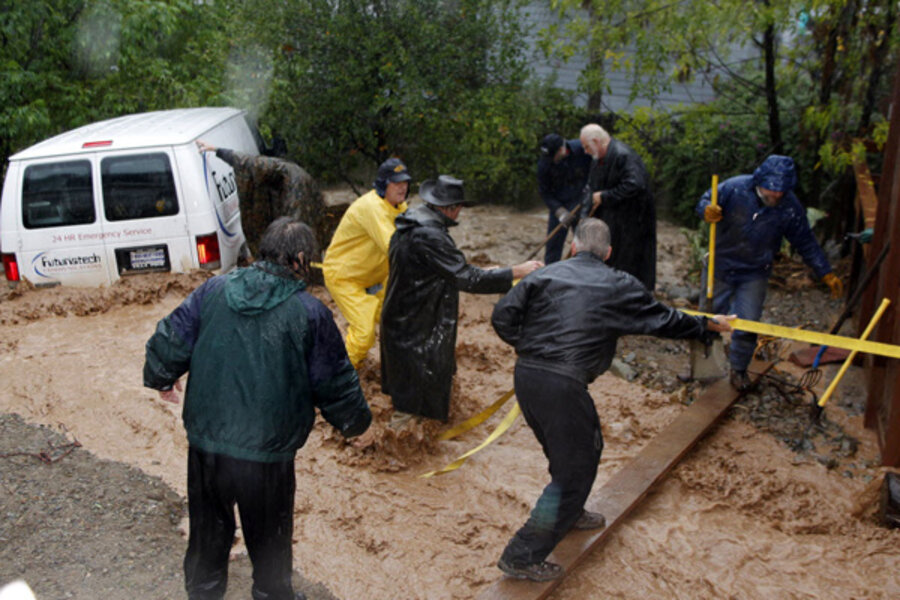When is mudslide danger greatest? Lessons from California storms
Loading...
| Los Angeles
Of the many dangers posed by the torrential rains socking southern California this week, mudslides and their accompanying debris flows probably pose the biggest threat – and people living in the region's many hillsides and canyons need to be alert, officials here warn.
Short bursts of dense rain, those approaching one inch an hour, are the conditions that tend to wreak the most havoc on hillsides, say officials ranging from Caltrans to the US Geological Survey (USGS). The threat of a slide is particularly acute where land has been denuded by wildfire, they add.
Those are the very conditions that confront the greater Los Angeles area. Los Angeles got three-quarters of an inch per hour overnight – coming on top of four straight days of rain that broke an 89-year record for precipitation.
IN PICTURES: California's great storms of December 2010
“People don’t really understand how truly destructive and dangerous debris flows can be,” says Susan Cannon, a research geologist with the US Geological Survey (USGS) stationed in Los Angeles, now home for the holidays. “If you’re in a burned-out area and get an evacuation notice, take it very, very seriously.” In southern California's San Bernardino, she notes,16 people died in 2003 when they couldn't get out of the way of a muddy debris flow in time.
“All last winter we had stories of people running for their lives,” she says, noting one incident in which a football-field-size catch basin in Dunsmore Canyon, near the northernmost section of Glendale, was covered 60 feet deep with mud. “The stories usually happen at night in the rain, with a wall of mud barreling down on someone with the speed of a locomotive.”
One problem area officials are watching is a 250-square-mile swath in the of foothills near La Canada Flintridge and La Crescenta, north of Los Angeles, which were stripped of most vegetation during the huge Station Fire 16 months ago. In February, rain and mud damaged at least 50 homes there, and people had to evacuate in a hurry, Cannon says.
Much has been learned in the past decade, as researchers have studied mudslide threats in the area. The USGS has coordinated with the National Weather Service to build models of how much saturation different kinds of soil can take, estimate the amount of water expected from coming storms, and then make their evacuation warnings accordingly. Variables include what areas have had vegetation denuded by fire, and how much leaves and other woody debris have been removed by residents. Researchers have also learned that when plants are burning, they release a gas into the soil that produces a waxy layer inches beneath the turf. That waxy layer halts water infiltration – and creates a slippery slide for soil sitting above it, paving the way for a landslide.
Conversely, a less severe fire might not consume all the litter and dust underneath plants, making the charred area less prone to erosion than hills burned down to nothing. Moreover, when nearby residents remove leaves and sticks from burned areas, they are in effect reducing a hillside’s ability to act as a sponge and are increasing the risk of mudslide, experts say.
“We used to think it was the soil’s water repellency alone that controlled the process,” says Cannon. “But now we’ve learned that removing all the decomposing vegetation and stems has a bigger influence.”
Other experts say California still has more to learn, especially about taking information about mudslide dangers and translating it into zoning codes that affect where people can and can't live.
“A once-in-a-decade storm is really not that big, so if they are having all this damage from this level of storm, that is kind of odd,” says Robert Traver, a professor of civil and environmental engineering and the director of the Villanova Urban Stormwater Partnership at the university in Philadelphia. “People moving into subdivisions and homebuilders who design them should be developing the codes that prevent destruction – or shouldn’t be going in there in the first place.”
But as Caltrans officials dispatch earthmovers to clean up debris and cement barriers to direct mud flows away from homes, residents themselves are also scrambling.
“I’ve pushed these boulders into a 'V' in case my neighbor’s backyard shoots down this way,” says Gus Demoss, a homeowner in Coldwater Canyon in Sherman Oaks, just north of L.A. in the San Fernando Valley.
Officials, though, warn that such makeshift maneuvers can't be counted on to provide protection.
“This mud can carry large boulders and tree trunks at huge rates of speed,” says Cannon. “It’s not the type of thing that will be stopped by people standing around with shovels and small fences.”
IN PICTURES: California's great storms of December 2010





